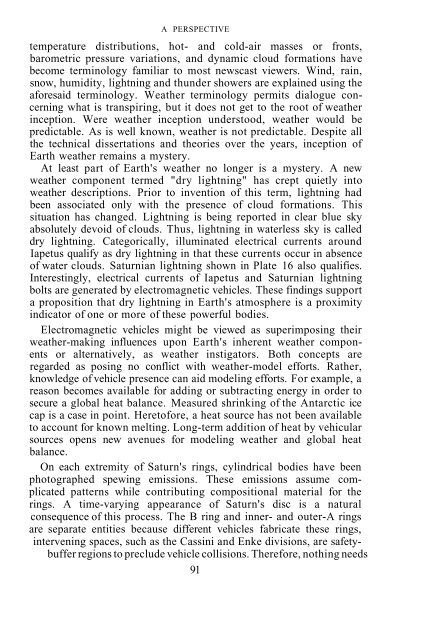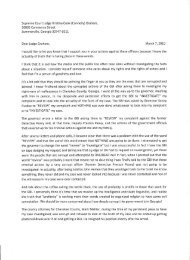Ringmakers of Saturn PDF - Patrick Crusade
Ringmakers of Saturn PDF - Patrick Crusade
Ringmakers of Saturn PDF - Patrick Crusade
Create successful ePaper yourself
Turn your PDF publications into a flip-book with our unique Google optimized e-Paper software.
A PERSPECTIVE<br />
temperature distributions, hot- and cold-air masses or fronts,<br />
barometric pressure variations, and dynamic cloud formations have<br />
become terminology familiar to most newscast viewers. Wind, rain,<br />
snow, humidity, lightning and thunder showers are explained using the<br />
aforesaid terminology. Weather terminology permits dialogue concerning<br />
what is transpiring, but it does not get to the root <strong>of</strong> weather<br />
inception. Were weather inception understood, weather would be<br />
predictable. As is well known, weather is not predictable. Despite all<br />
the technical dissertations and theories over the years, inception <strong>of</strong><br />
Earth weather remains a mystery.<br />
At least part <strong>of</strong> Earth's weather no longer is a mystery. A new<br />
weather component termed "dry lightning" has crept quietly into<br />
weather descriptions. Prior to invention <strong>of</strong> this term, lightning had<br />
been associated only with the presence <strong>of</strong> cloud formations. This<br />
situation has changed. Lightning is being reported in clear blue sky<br />
absolutely devoid <strong>of</strong> clouds. Thus, lightning in waterless sky is called<br />
dry lightning. Categorically, illuminated electrical currents around<br />
Iapetus qualify as dry lightning in that these currents occur in absence<br />
<strong>of</strong> water clouds. <strong>Saturn</strong>ian lightning shown in Plate 16 also qualifies.<br />
Interestingly, electrical currents <strong>of</strong> Iapetus and <strong>Saturn</strong>ian lightning<br />
bolts are generated by electromagnetic vehicles. These findings support<br />
a proposition that dry lightning in Earth's atmosphere is a proximity<br />
indicator <strong>of</strong> one or more <strong>of</strong> these powerful bodies.<br />
Electromagnetic vehicles might be viewed as superimposing their<br />
weather-making influences upon Earth's inherent weather components<br />
or alternatively, as weather instigators. Both concepts are<br />
regarded as posing no conflict with weather-model efforts. Rather,<br />
knowledge <strong>of</strong> vehicle presence can aid modeling efforts. For example, a<br />
reason becomes available for adding or subtracting energy in order to<br />
secure a global heat balance. Measured shrinking <strong>of</strong> the Antarctic ice<br />
cap is a case in point. Heret<strong>of</strong>ore, a heat source has not been available<br />
to account for known melting. Long-term addition <strong>of</strong> heat by vehicular<br />
sources opens new avenues for modeling weather and global heat<br />
balance.<br />
On each extremity <strong>of</strong> <strong>Saturn</strong>'s rings, cylindrical bodies have been<br />
photographed spewing emissions. These emissions assume complicated<br />
patterns while contributing compositional material for the<br />
rings. A time-varying appearance <strong>of</strong> <strong>Saturn</strong>'s disc is a natural<br />
consequence <strong>of</strong> this process. The B ring and inner- and outer-A rings<br />
are separate entities because different vehicles fabricate these rings,<br />
intervening spaces, such as the Cassini and Enke divisions, are safetybuffer<br />
regions to preclude vehicle collisions. Therefore, nothing needs<br />
91



